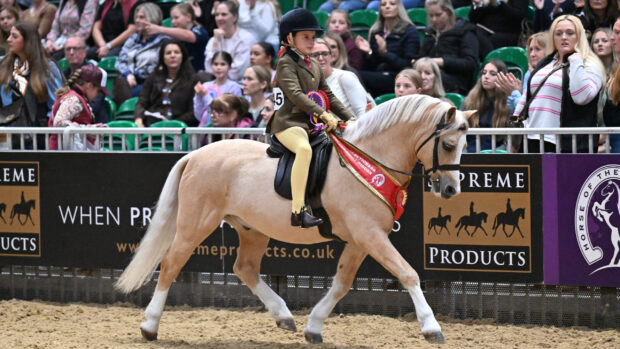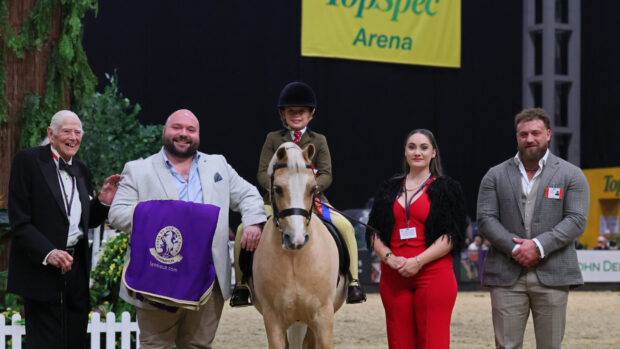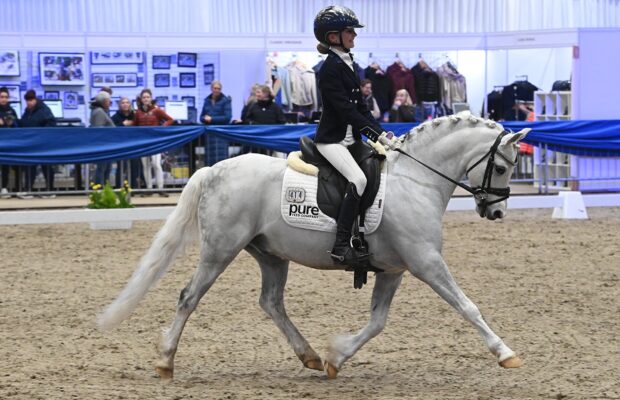Looking to buy a New Forest pony? The versatile breed should definitely be considered if you’re looking for a hardy, intelligent and fun pony to enjoy or compete.
What is a New Forest pony?
The New Forest is one of the British native breeds. The New Forest is a popular choice for many disciplines due to their variation in height, versatility and ability to turn their hoof to many different spheres. New Forest ponies have an ever increasing presence in the show ring in both flat and working hunter classes. The 2023 Horse of the Year Show (HOYS) ridden M&M champion was the stallion Vynnes Magical Edition. They also make a great choice for other disciplines, from Pony Club to eventing, from hunting to showjumping.
The New Forest Pony Breeding and Cattle Society is the guardian of the breed: “The earliest record of horses in the New Forest dates back to 1016 when rights of common pasture were granted to the people living in what was a royal hunting ground. Since then, either as specific attempts to improve the breed or just as part of the normal life and trade in the New Forest, many outside breeds were introduced. Notable bloodlines were Welsh, Thoroughbred, Arab and Hackney. Later, another concerted effort was made to improve the New Forest blood and other British Isles pony bloodlines were introduced to achieve this, including Fell Ponies, Dales, Highlands, Dartmoor and Exmoor.”
The New Forest pony has an upper height limit of 148cm and there is no lower height limit. New Forest ponies may be any colour except piebald, skewbald, spotted or blue-eyed cream. Palomino or very light chestnut and cream ponies with dark eyes are not eligible as licensed stallions.
The society provides the following breed standard for the New Forest pony:
Type: New Forest ponies should be of working type with substance. They should have sloping shoulders, strong quarters, plenty of flat bone, good depth of body, straight limbs and good hard round feet. The ponies are quite capable of carrying adults, while narrow enough for small children. The smaller ponies, though not up to so much weight, often show more quality.
Action: This should be free, active and straight, but not exaggerated.
Temperament: The New Forest Pony has an amenable temperament that generally makes it very suitable for multiple disciplines.
White markings: Other than on the head and lower limbs: loss of, or absence of, pigment in hair or skin that is not known to have been associated solely with skin trauma, is not acceptable. So, for the purposes of entry into the approved section of the studbook, a pony shall not have any white markings on pink skin behind the head, above a horizontal line level with the bony protuberance of the accessory carpal bone at the back of the knee in the forelimb, and the point of the hock in the hind limb, unless proven to be due to trauma/injury.
What should I look for in a New Forest?
Vee Taheri-Sinfield is a judge and a breed enthusiast who has competed New Forests for many years at top level. She mainly competes in working hunter classes, producing ponies through the ranks. In 2013 she made history when her pony Mallards Wood Full Monty became the first New Forest to win a Royal International Horse Show (RIHS) working hunter final.
“Whether you want to show, jump, event or do Pony Club, the New Forest is a good choice,” Vee begins. “Temperament is paramount and it’s an essential characteristic to look out for, alongside breed type, which is so important and should not be overlooked.
“The head of a New Forest should be plain – it does not need to be pretty. Movement should be straight and not exaggerated; these ponies were bred to survive on hostile terrain, not on picnic lawns as some are led to believe! They have been required to navigate bogs, ponds, steams and dense woodlands so hardiness is also a key trait.
“Ponies should have a sufficient amount of good, clean bone for their size; I like to see at least 7.5 inches. They should have a set of strong and open feet, not too upright or low on the heels; most ponies can compete and be worked barefoot.
“The upper height limit is 148cm however some of the up-to-height ponies can lose their pony characteristics,” Vee adds. “Well-balanced and proportioned ponies should remain true to type if scaled up or down.
“The New Forest will always be my choice; they combine temperament, bravery and willingness in equal measures. I would also never rule out a part-bred New Forest if you are looking to showjump, event or do dressage.”
Leading showing judge Malcolm Fry tells H&H: “The New Forest can be tricky to judge in many ways due to the range of types, shapes and sizes found within the breed, and the fact they’re classified as a large breed despite having no lower height limit. The bigger ponies tend to be more successful as they’re more commercial, however smaller ponies are being overlooked less and less as judges become more educated.
“You can have two lovely ponies, one more sporty with flash and movement, and one more typey, perhaps a Forest-bred pony with more limb and substance, competing against each other,” Malcolm adds. “We’re lucky to have both, the pony that is representing the type and the other which can stand up against the flashier breeds in the ring. As a breed we’re hot on good limbs, quality bone, good feet – necessary in any breed – short cannons, big joints, depth of body and a good, strong front.”
I want to buy a New Forest pony – where should I look?
There are online sale sites that have New Forest ponies advertised when they come up for sale from private sellers, professional breeders and horse dealers. Ponies also sell via word of mouth.
“Approaching breeders with a good reputation is a good place to start,” advises Vee. “If you’re adventurous and have a good eye for a pony, you can also pick up a good youngster or a foal from the annual Beaulieu Road Pony Sales.
“While they do come on the open market at times, the New Forest tends to stay in the family for a while; they’re versatile and can be handed to various members of the family so they always have a job,” Vee adds. “Personally, I like to buy youngsters to back, bring on and compete. Often, I keep a pony for years, though, as they’re such a joy to have around.”
How much should I expect to pay?
The price of a pony will depend on several factors, including breeding, age and competition record.
“I don’t tend to spend a lot of money on ponies as I prefer to buy foals or raw youngsters,” Vee explains. “I have bought top ponies for hundreds rather than thousands as I got them as weedy youngsters that I thought had potential.
“Prices do vary, but on average you should expect to spend no less than £3,000 on a quality pony that is ready to do a job, though you could probably get a smaller or a more Pony Club quality pony for less. Some over-height Foresters that have made top event or competition ponies can be worth a fortune. In today’s market where the New Forest is a highly valued breed, the sky really is the limit.”
What happens when I’ve agreed to buy a New Forest pony?
If you decide to purchase a pony it is time to organise a pre-purchase vetting, something that is strongly recommended. It’s important to let the vet know prior to the vetting what you intend to use the pony for so they can assess it accordingly.
“I do not tend to have ponies vetted, but I would always feel more confident selling a pony that has been vetted and would recommend a two-stage vet assessment at the least if you are less experienced,” Vee says.
For more information, you can read H&H’s ultimate guide to buying a horse.
You might also like to read

How to buy the perfect Dartmoor pony for either yourself or a child

How can I buy my perfect Connemara pony?

Is an Exmoor pony right for you? Tips from a breeder on buying your perfect one

On the hunt for a Welsh section A pony? Then you need to read this first…

How to buy a Dales pony, plus what to look for in a quality example of this native breed

Subscribe to Horse & Hound magazine today – and enjoy unlimited website access all year round




